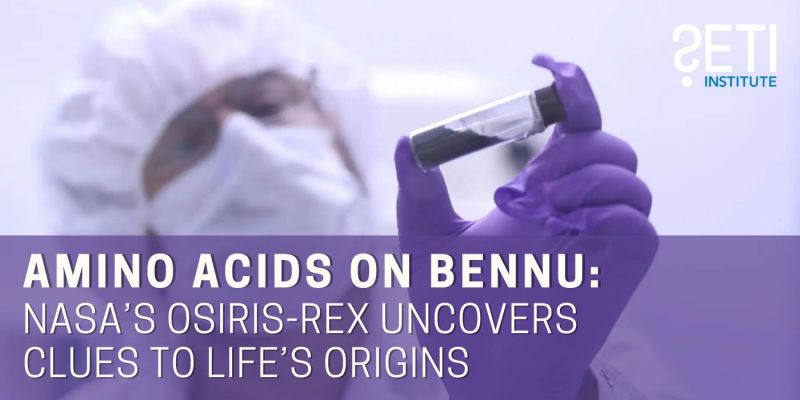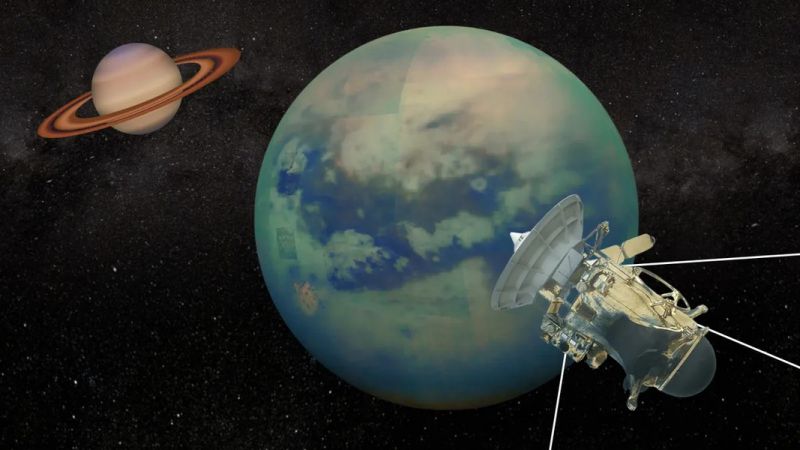
By Seth Shostak, Senior Astronomer
This week, a robotic spacecraft bearing the unwieldy name OSIRIS-REX silently sidled up to a small asteroid, one of millions that ply the dark spaces of the solar system. The spacecraft was there to collect a small sample of material – dusty rock that could shed light on two of science’s most intriguing puzzles: How was the solar system formed, and did that process bequeath its planets any of the necessary molecules for life?
If you could go back in time and visit our small part of the galaxy 4.6 billion years ago, you wouldn’t find the Earth, the Sun, or any of the other familiar components of the solar system. They didn’t exist. Instead, you would encounter a strange soup: a scramble of dark grains afloat in a cloud of gas. But if you had the patience to wait a few million years, you would see these materials self-assemble into planets, moons, comets, asteroids, and the Sun. You’d witness the slow, quiet birth of the solar system.
At least, that is what we think you’d see. But planetary scientists still aren’t sure of the details. And we can’t go back billions of years to sharpen our understanding. But what we can do is take a leaf from the paleontologists’ book. They can’t return to the Mesozoic to study the evolution of the dinosaurs, so they examine fossils, remnants from the past that can tell the story.

The OSIRIS-REX mission is searching for geologic remnants; material that was present during the birth of our solar system – 50 times older than dinosaur bones. And it’s doing so in a first-rate fossil field: an asteroid named Bennu.
Go to a NASA web site, and you’ll find plenty of stunning photos of Bennu. It’s rhomboid in shape, and carpeted by loose rubble. It’s darker than an asphalt highway and small enough to fit in the Oakland Coliseum.
But the most interesting thing about Bennu is its age. The pebbles and rocks that litter its surface are the same materials that built the planets, and they’ve remained largely unchanged for billions of years. They’re dusty leftovers that we expect to be as informative as dinosaur bones.
However, as the advertising copy says, “there’s more.” In addition to being the raw materials of planets, the rubble littering Bennu might also contain compounds that were necessary to spawn life. That would be incredibly interesting, for it would show that the rain of asteroids that collided with the young Earth was critical to the emergence of biology.
The OSIRIS-REX mission has been long. The spacecraft reached Bennu’s vicinity two years after its 2016 launch, carefully matching its speed to that of the asteroid. It has assiduously made photographs so that mission scientists could choose the best places to grab a sample. In a tour de force of space engineering, it used small thrusters to precisely pace the asteroid’s trajectory and rotation.
On Tuesday, October 20, the sampling arm, whose business end resembles a Honda air filter, was extended down to Bennu’s surface. Exhaling a brief blast of nitrogen gas, it stirred up loose rock, packing some of it into its collector head. The entire sampling process took but a few seconds, after which the spacecraft backed away.
Two years of travel and the delicate adjustment of the spacecraft’s trajectory were all in the service of those few seconds. How much material was gathered is, as yet, unknown. The minimum science requirement is two ounces – enough to fill a perfume bottle. If the sample is less, OSIRIS-REX has enough nitrogen to attempt two more grabs.
Next Spring, OSIRIS-REX will bid Bennu farewell and start its return trip to Earth. The gritty specimen in its bowels cost four years and a trillion dollars. Eventually that material will be robotically packed into a capsule and dropped onto the Utah desert for retrieval.
At that point, scientists will begin their work. And the mission has provoked considerable excitement.
“We will undoubtedly learn something about the sort of prebiotic material that asteroids brought to Earth billions of years ago,” says John Marshall, a planetary scientist at the SETI Institute and a member of the OSIRIS-REX team. “This may prove that very slow chemistry in space – long before our planet was even born – could be a necessary part of biological evolution.”
If that turns out to be true, humankind will have learned something essential about its own existence.
Tomar muestra de antiguo cascajo
Por Seth Shostak, astrónomo senior
Traducido por Lourdes Cahuich
Esta semana, una sonda robótica con el pesado nombre OSIRIS-REX se acercó silenciosamente a un pequeño asteroide, uno de los millones que surcan los espacios oscuros del Sistema Solar. La sonda estaba allí para recolectar una pequeña muestra de material: roca polvorienta que podría arrojar luz sobre dos de los acertijos más intrigantes de la ciencia: ¿Cómo se formó el sistema solar? ¿Y ese proceso legó a sus planetas alguna de las moléculas necesarias para la vida?
Si pudieras retroceder en el tiempo y visitar nuestra pequeña parte de la galaxia hace 4 600 millones de años, no encontrarías a la Tierra, al Sol o alguno de los otros componentes familiares del sistema solar. No existían. En cambio, te encontrarás con una sopa extraña: una mezcla de granos oscuros flotando en una nube de gas. Pero si tuvieras la paciencia de esperar unos pocos millones de años, verías estos materiales auto ensamblarse en planetas, satélites, cometas, asteroides y el Sol. Serías testigo del lento y silencioso nacimiento del Sistema Solar.
Al menos, eso es lo que creemos que verá. Pero los científicos planetarios aún no están seguros de los detalles. Y no podemos retroceder miles de millones de años para agudizar nuestra comprensión. Pero lo que podemos hacer es tomar una hoja del libro de los paleontólogos. No pueden regresar al Mesozoico para estudiar la evolución de los dinosaurios, por lo que examinan fósiles, restos del pasado que pueden contar la historia.

La misión OSIRIS-REX está buscando restos geológicos: material que estuvo presente durante el nacimiento de nuestro sistema solar, 50 veces más antiguo que los huesos de dinosaurio. Y lo está haciendo en un campo fósil de primer orden: un asteroide llamado Bennu.
Vaya al sitio web de NASA y encontrará muchas fotos impresionantes de Bennu. Tiene forma romboidal y está alfombrado por escombros sueltos; es más oscuro que una carretera de asfalto y lo suficientemente pequeño como para caber en el Oakland Coliseum.
Pero lo más interesante de Bennu es su edad. Los guijarros y las rocas que cubren su superficie son los mismos materiales que construyeron los planetas, y se han mantenido prácticamente sin cambios durante miles de millones de años. Son sobras polvorientas que esperamos sean tan informativas como huesos de dinosaurio.
Sin embargo, como dicen en la publicidad "...pero hay más". Además de ser la materia prima de los planetas, los escombros que ensucian Bennu también podrían contener compuestos que fueron necesarios para generar vida. Eso sería increíblemente interesante, ya que mostraría que la lluvia de asteroides que chocó con la Tierra joven fue fundamental para el surgimiento de la biología.
La misión OSIRIS-REX ha sido larga. La sonda llegó a las cercanías de Bennu dos años después de su lanzamiento en 2016, ajustando cuidadosamente su velocidad a la del asteroide. Ha realizado fotografías asiduamente para que los científicos de la misión pudieran elegir los mejores lugares para tomar una muestra. En un tour de force de la ingeniería espacial, se usaron pequeños propulsores para marcar con precisión la trayectoria y la rotación del asteroide.
El martes 20 de octubre, el brazo de muestreo, cuyo extremo funcional se asemeja a un filtro de aire Honda, se extendió hasta la superficie de Bennu. Exhaló una breve ráfaga de gas nitrógeno, removió la roca suelta y metió parte de ella en su cabezal colector. Todo el proceso de muestreo tomó solo unos segundos, después de lo cual la nave espacial retrocedió.
Dos años de viaje y el delicado ajuste de la trayectoria del orbitador al servicio de esos pocos segundos. Hasta el momento se desconoce cuánto material se reunió. El requisito científico mínimo es de dos onzas, suficiente para llenar una botella de perfume. Si la muestra es menor, OSIRIS-REX tiene suficiente nitrógeno para intentar dos recolecciones más.
La próxima primavera, OSIRIS-REX se despedirá de Bennu y comenzará su viaje de regreso a la Tierra. El espécimen arenoso en sus entrañas costó cuatro años y un billón de dólares. Eventualmente, ese material se empaquetará robóticamente en una cápsula y se dejará caer en el desierto de Utah para su recuperación.
En ese momento, los científicos comenzarán su trabajo. Y la misión ha provocado una gran expectación.
“Sin duda, aprenderemos algo sobre el tipo de material prebiótico que los asteroides trajeron a la Tierra hace miles de millones de años”, dice John Marshall, científico planetario del Instituto SETI y miembro del equipo OSIRIS-REX. "Esto puede probar que la química lenta en el espacio, mucho antes de que naciera nuestro planeta, podría ser una parte necesaria de la evolución biológica".
Si eso resulta ser cierto, la humanidad habrá aprendido algo esencial sobre su propia existencia.





